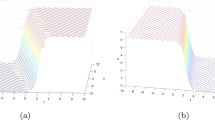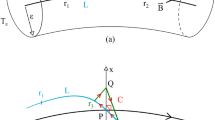Abstract
Neuronal cable theory is usually derived from an electric analogue of the membrane, which contrasts with the slow movement of ions in aqueous media. We show here that it is possible to derive neuronal cable equations from a different perspective, based on the laws of hydrodynamic motion of charged particles (Navier–Stokes equations). This results in similar cable equations, but with additional contributions arising from nonlinear interactions inherent to fluid dynamics, and which may shape the integrative properties of the neurons. The model recovers the classic cable equations as a particular case, when the fluid is assumed to be linear.
Similar content being viewed by others
References
Bédard, C., Destexhe, A.: Generalized cable theory for neurons in complex and heterogeneous media. Phys. Rev. E 88, 022709 (2013)
Cremer, J.: Zum kernleiterproblem. Z. Biol. 37, 550–553 (1899)
Dayan, P., Abbott, L.F.: Theoretical Neuroscience. MIT Press, Cambdridge (2005)
Destexhe, A., Bedard, C.: Do neurons generate monopolar current sources? J. Neurophysiol. 108, 953–955 (2012)
Forcella, D., Prada, C., Carminati, R.: Causality, nonlocality, and negative refraction. Phys. Rev. Lett. 118(13), 134301 (2017)
Forster, D.D.: Hydrodynamic Fluctuations, Broken Symmetries and Correlation Functions. Benjamin-Cummings, Reading (1975)
Gabriel, S., Lau, R.W., Gabriel, C.: The dielectric properties of biological tissues: II. Measurements in the frequency range 10 Hz to 20 GHz. Phys. Med. Biol. 41, 2251–2269 (1996)
Gomes, J.M., Bédard, C., Valtcheva, S., Nelson, M., Khokhlova, V., Pouget, P., Venance, L., Bal, T., Destexhe, A.: Intracellular impedance measurements reveal non-ohmic properties of the extracellular medium around neurons. Biophys. J. 110, 234–246 (2016)
Hartnoll, S.A., Kovtun, P.K., Muller, M., Sachdev, S.: Theory of the Nernst effect near quantum phase transitions in condensed matter, and in dyonic black holes. Phys. Rev. B 76, 144502 (2007)
Hermann, L.: Beiträge zur physiologie und physik des nerven. Arch Gesamte Physiol Menschen Tiere 109(3), 95–144 (1905)
Hille, B.: Ionic Channels of Excitable Membranes. Sinauer Associates Inc, Sunderland (2001)
Hodgkin, A.L., Huxley, A.F.: A quantitative description of membrane current and its application to conduction and excitation in nerve. J. Physiol. Lond. 117, 500–544 (1952)
Kadanoff, L.P., Martin, P.C.: Hydrodynamic equations and correlation functions. Ann. Phys. 24, 419 (1963)
Koch, C.: Biophysics of Computation. Oxford University Press, Oxford (1999)
Landau, L.D., Lifschitz, E.M.: Fluid Mechanics, 3rd edn. Pergamon Press, Oxford (1966)
Philip, M., Bolton, W.: Technology of Engineering Materials. Elsevier, New York (2002)
Rall, W.: Electrophysiology of a dendritic neuron model. Biophys. J. 2, 145–167 (1962)
Rall, W.: The Theoretical Foundations of Dendritic Function. MIT Press, Cambridge (1995)
Riera, J.J., Ogawa, T., Goto, T., Sumiyoshi, A., Nonaka, H., Evans, A., Miyakawa, H., Kawashima, R.: Pitfalls in the dipolar model for the neocortical EEG sources. J. Neurophysiol. 108, 956–975 (2012)
Tuckwell, H.C.: Introduction to Theoretical Neurobiology: Linear Cable Theory and Dendritic Structure. Cambridge University Press, Cambdridge (1988)
Acknowledgements
We thank Claude Bedard for useful discussions. Research funded by the CNRS, the European Community (H2020-720270, H2020-785907), the ANR (PARADOX) and the ICODE excellence network.
Author information
Authors and Affiliations
Corresponding author
Additional information
Publisher's Note
Springer Nature remains neutral with regard to jurisdictional claims in published maps and institutional affiliations.
Rights and permissions
Springer Nature or its licensor (e.g. a society or other partner) holds exclusive rights to this article under a publishing agreement with the author(s) or other rightsholder(s); author self-archiving of the accepted manuscript version of this article is solely governed by the terms of such publishing agreement and applicable law.
About this article
Cite this article
Forcella, D., Romagnoni, A. & Destexhe, A. Neuronal cable equations derived from the hydrodynamic motion of charged particles. Z. Angew. Math. Phys. 74, 89 (2023). https://doi.org/10.1007/s00033-023-01986-y
Received:
Revised:
Accepted:
Published:
DOI: https://doi.org/10.1007/s00033-023-01986-y




